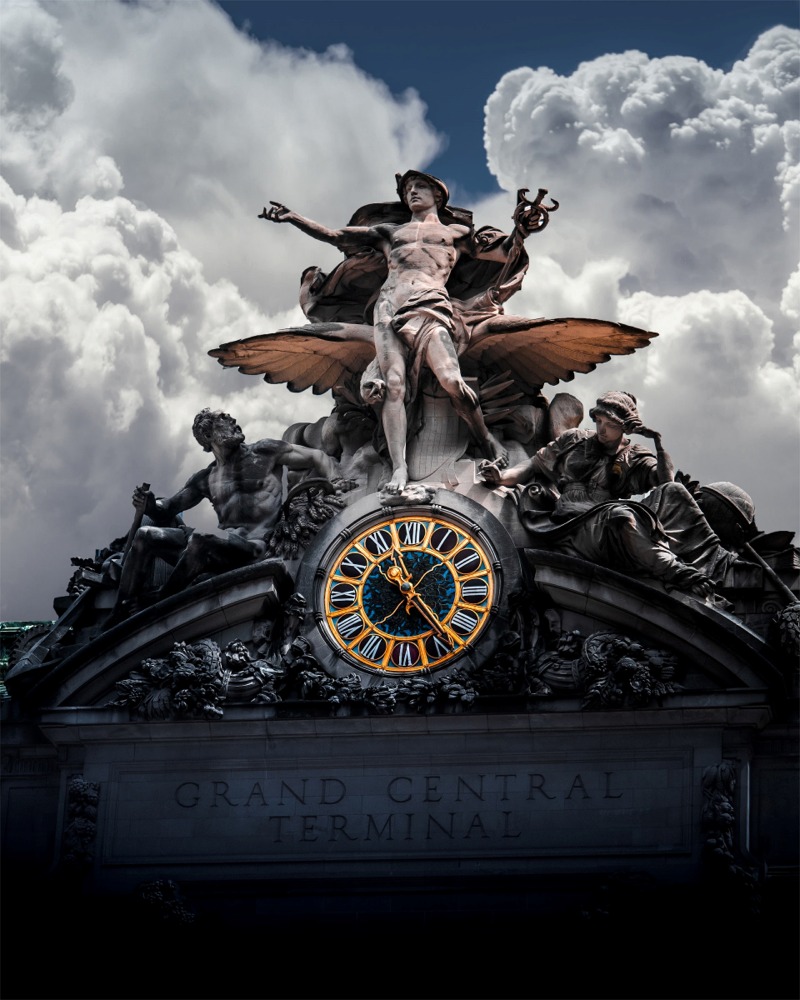Transportation / The Glory of Commerce Statue
Home > New York State Photographs > Grand Central Terminal > Transportation / The Glory of Commerce Statue

WOW, what a spectacular photograph of the statue of "Transportation" or alternatively "The Glory of Commerce" that adorns the top of Grand Central Terminal facing south. You can also see the Tiffany Clock beneath the statue of Mercury.
Glory of Commerce / Transportation
The Glory of Commerce sculptural group rests atop the terminal's facade, directly above a broken pediment featuring a large clock. The work is also known as Progress with Mental and Physical Force or Transportation. It is about 48 feet (15 m) tall, 66 feet (20 m) wide, and weighs about 1,500 short tons (1,400 t). At its unveiling in 1914, the work was considered the largest sculptural group in the world.
The work includes representations of Minerva, Hercules, and Mercury. The sculptures were designed by French sculptor Jules-Félix Coutan and carved by the John Donnelly Company. Coutan created the model in his Paris studio and shipped it to New York City later.
Mercury is standing at the top center of the work, depicted traditionally with a caduceus and wearing a winged helmet, with loose drapery concealing otherwise complete nudity. He is standing in a contrapposto pose in front of an eagle, wings outstretched, peering around his right leg. Two other gods are depicted to Mercury's left and right: the male figure to his right is typically and officially deemed to be Hercules, though he lacks the god's characteristic club and lionskin. Instead, the god is depicted among an anchor, cogwheel, anvil and hammer, a beehive, grapes, wheat ears and a sickle. Many of these are symbols of Vulcan, who is depicted with Minerva and Mercury in other works. He is also nearly naked, staring at Mercury above him. The female figure, Minerva, is resting her head on her left arm, looking down at a roll of parchment on her lap. She is depicted among a globe, a measuring compass, volumes of books and thick wreaths of laurel.
The work is seen as attempting to fulfil several goals: portraying the terminal itself as a new technology, representing the Vanderbilt family, and serving as an artistic piece to parallel European art and architecture of the time.
The Tiffany Clock
There is a 13-foot-wide (4.0 m) Tiffany clock on top of the south facade. The clock face uses Roman numerals; its numeral "IIII" is traditional for clock faces displaying the number four, instead of the more common "IV". The numeral "VI", on the bottom of the clock, hides a flap that is used for maintenance.
Mercury
Mercury (/ˈmɜːrkjʊri/; Latin: Mercurius [mɛrˈkʊrijʊs] is a major god in Roman religion and mythology, being one of the 12 Dii Consentes within the ancient Roman pantheon. He is the god of financial gain, commerce, eloquence, messages, communication (including divination), travellers, boundaries, luck, trickery, and thieves; he also serves as the guide of souls to the underworld.
In Roman mythology, he was considered to be either the son of Maia, one of the seven daughters of the Titan Atlas, and Jupiter, or of Caelus and Dies. In his earliest forms, he appears to have been related to the Etruscan deity Turms; both gods share characteristics with the Greek god Hermes. He is often depicted holding the caduceus in his left hand. Similar to his Greek equivalent Hermes, he was awarded a magic wand by Apollo, which later turned into the caduceus, the staff with intertwined snakes.
Hercules
Hercules (/ˈhɜːrkjʊˌliːz/, US: /-kjə-/) is the Roman equivalent of the Greek divine hero Heracles, son of Jupiter and the mortal Alcmene. In classical mythology, Hercules is famous for his strength and for his numerous far-ranging adventures.
The Romans adapted the Greek hero's iconography and myths for their literature and art under the name Hercules. In later Western art and literature and in popular culture, Hercules is more commonly used than Heracles as the name of the hero. Hercules is a multifaceted figure with contradictory characteristics, which enabled later artists and writers to pick and choose how to represent him. This article provides an introduction to representations of Hercules in the later tradition.
Minerva
Minerva /məˈnɜːrvə/ (Latin: [mɪˈnɛrwa]; Etruscan: Menrva) is the Roman goddess of wisdom, justice, law, victory, and the sponsor of arts, trade, and strategy. Minerva is not a patron of violence such as Mars, but of defensive war only. From the second century BC onward, the Romans equated her with the Greek goddess Athena. Minerva is one of the three Roman deities in the Capitoline Triad, along with Jupiter and Juno.
She was the virgin goddess of music, poetry, medicine, wisdom, commerce, weaving, and the crafts. She is often depicted with her sacred creature, an owl usually named as the "owl of Minerva", which symbolised her association with wisdom and knowledge as well as, less frequently, the snake and the olive tree. Minerva is commonly depicted as tall with an athletic and muscular build, as well as wearing armour and carrying a spear. As the most important Roman goddess, she is highly revered, honored, and respected. Marcus Terentius Varro considered her to be ideas and the plan for the universe personified.
From Wikipedia, the free encyclopedia.


